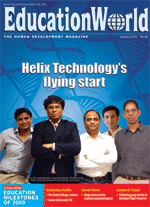 Congratulations to the Helix Technology team for inventing the TeachNext Box (cover story, EW January). It’s so rare to read about an Indian invention especially in the education technology space. If publicised and promoted properly among schools, I’m sure TeachNext will find wide acceptance in the teachers’ community and help them deliver lessons in more stimulating ways. Particularly against the backdrop of high teacher absenteeism and poorly trained teachers, its K-10 content mapped to the NCERT syllabus will prove a boon for school managements and students. The real challenge is how to reach the benefits of TeachNext to the tech-averse teachers’ community.
Congratulations to the Helix Technology team for inventing the TeachNext Box (cover story, EW January). It’s so rare to read about an Indian invention especially in the education technology space. If publicised and promoted properly among schools, I’m sure TeachNext will find wide acceptance in the teachers’ community and help them deliver lessons in more stimulating ways. Particularly against the backdrop of high teacher absenteeism and poorly trained teachers, its K-10 content mapped to the NCERT syllabus will prove a boon for school managements and students. The real challenge is how to reach the benefits of TeachNext to the tech-averse teachers’ community.
It was inspiring to read that the IIT-IIM team of young entrepreneurs at Helix have given up high-paying corporate careers to invest their savings and time to promote an education company committed to improving student learning outcomes in schools across the country. They deserve our full praise and encouragement for venturing into the not-so-glamorous world of Indian education.
Ramesh Singhvi
Delhi
Sibal’s misplaced priorities
In your special report ‘Education milestones of 2009’ (EW January), you have highlighted the appointment of Kapil Sibal as Union HRD minister as a landmark education event of the past year. Though I agree that compared to his predecessor Arjun Singh, Sibal is a great improvement, I don’t think he deserves the rich praise you have heaped upon him for reviving India’s deteriorating education system. Merely announcing grandiose education reform plans to the press doesn’t make Sibal an extraordinary leader. To deserve the nation’s praise he must first implement and achieve his education reform agenda.
Moreover I’d like to draw your and EW readers’ attention to the fact that all his reforms are centred around elite CBSE schools, not poorly equipped government schools. The majority of CBSE affiliated schools are privately run, well-funded and staff-ed, and don’t require ministerial attention. It’s the country’s pathetically provided government schools which require Sibal’s attention. But sadly he seems to have aban-doned them. He hasn’t announced a single plan to upgrade reso-urces, check teacher absenteeism and impr-ove student learning outcomes in government schools. I hope in the new year he focuses his energies on modernising India’s dismal government schools which poor children attend rather than private schools patronised by the pampered middle class.
Sujit Bhattacharya
Kolkata
Against national interest
I refer to your editorial ‘Need for new States Reorganisation Commission’ (EW January). The demand for a separate state of Telangana and other new states is not in the interest of the nation. An increase in the number of states will make the problems of running them even greater. Just as joint families are better than nuclear ones, national unity is better than division. In bigger states, a diverse population learns to live in harmony. As the inhabitants become more accommodating, the state also grows economically. This is the argument for minimum number of states in India.
Following partition, it was with great difficulty that the states were created, thanks to the efforts of India’s first home minister Sardar Vallabhbhai Patel. There is no one left now of his calibre to resolve the present unrest for the good of the nation.
Mahesh Kumar on e-mail
Incorrect information
I read the December issue of EducationWorld with great attention and diligence, because I found the content educative. However, there were discrepancies in your information which I am detailing below:
• The name of Bangalore has changed to Bengaluru but in your address it is still Bangalore.
• In your special report feature ‘Uttar Pradesh’s islands of excellence’ in the box titled ‘Statistical Snapshot’, the number of districts in UP is indicated as 70, whereas now the number is 71.
• The number of members UP sends to the Lok Sabha is shown as 85 (of 543). In fact after the separation of Uttaranchal (now Uttarakhand) in November 2000, Uttar Pradesh sends 80 members to the Lok Sabha.
• The number of states of the Indian Union are indicated as 29. However to date there are 28 states and seven Union territories (including the National Capital Territory of Delhi).
• Further the spelling of Banaras is incorrectly shown as Benares. Although officially the name of the city is now Varanasi, the name of the university remains the same i.e Banaras Hindu University.
This is my maiden letter to the editor of a magazine or newspaper. I hope you will take it in the right spirit.
N.K. Kataria
New Delhi
Words of appreciation
Thank you very much for EducationWorld’s dedicated service to Indian education for over a decade. I quite agree with your general tenor that deterior-ation of the education system will result in growing wastage of the country’s abundant human resources.
In this connection Dr. Neeraj Kaushal’s observation (EW December) that a majority of teachers especially in government schools don’t teach, is shocking. But the changing classroom climate is also a reason.
Moreover your Postscript item ‘Bubble-head icons’ deserves kudos! It is evident that a majority of our youth have transformed into self-obsessed and amoral individuals. EW’s service is very much needed.
Prof. P. Selvaraj
Coimbatore